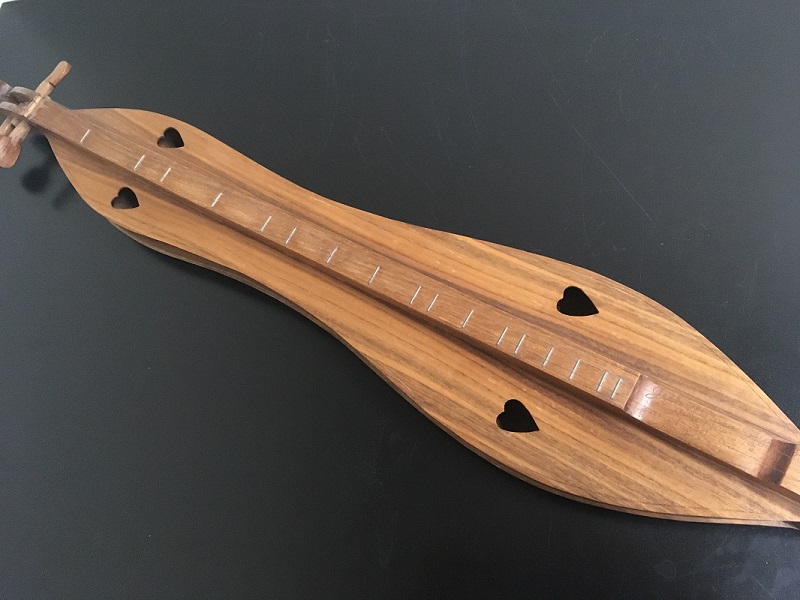University Libraries

Handmade Dulcimer: Both Art and Instrument
By Amy Rohmiller
Besides a legacy of carol sings, musical theater, instrumental music and memorable performances, the late career music educator and longtime music faculty member George Zimmerman left the University of Dayton a remarkable collection of instruments, among which is a handmade dulcimer from Kentucky.
The George Zimmerman Instrument Collection in the University Archives is made up of about 100 musical instruments from cowbells to flutes. Zimmerman donated the collection to University Archives after his retirement in 1994. The collection spans the world, from the continent of Africa to the countries of the former Yugoslavia, but one of the most significant instruments comes from much closer to home: a simple-looking dulcimer made in Kentucky.
Appalachian origins
If you’ve never heard of a dulcimer, you’re not alone. Although dulcimers are a traditional Appalachian folk instrument, they are less well known than fiddles and banjos, and the name applies to two different instruments. The hammered dulcimer is trapezoid-shaped with lots of strings and played by hitting the strings with a hammer. The dulcimer in our collection is a mountain dulcimer, with three strings, frets and a fretboard over a sound box (similar to a guitar or a banjo). You play mountain dulcimers by putting them in your lap and strumming or plucking the strings.1 You can play all types of music on a dulcimer. Most people think of bluegrass or folk songs like Whiskey Before Breakfast, but you can also play Bowie’s Space Oddity and have it sound amazing, too.
The dulcimer in our collection was made by Jethro Amburgey, a noted 20th-century dulcimer maker from Hindman, Kentucky. Amburgey was born in 1895, attended the Hindman Settlement School, fought in World War I as part of a machine gun company, and returned and graduated from Hindman in 1920. While at Hindman after the war, Amburgey learned to make dulcimers and purchased a set of dulcimer patterns from Ed Thomas, one of the most prolific dulcimer makers in Kentucky. Although Amburgey, like Thomas, became a well-known dulcimer maker, he also had a long, successful career as a high school teacher. He died in 1971 having made more than 1,200 dulcimers.2
The dulcimer in the Zimmerman collection is No. 920 and is dated Jan. 30, 1968. It’s fairly small and light; while it’s about three feet long, it’s only about six inches wide. After emailing with Terry Conners, an authority on Amburgey dulcimers, we think it’s made out of black walnut plywood. According to Conners, Amburgey began his career making dulcimers out of solid wood but switched sometime around 1964 because the wood started to crack — not good. Solid-wood dulcimers shrink when they dry out. Amburgey made his dulcimers in his moist basement workshop; when his dulcimers were kept in less humid conditions, they dried out and cracked. Switching to plywood prevented this from happening.3
Cultural, historical importance
Amburgey made most of his dulcimers like ours during the American folk revival that began after World War II and lasted through the 1960s. One of his early dulcimers is the first dulcimer well-known folk singer Jean Ritchie ever owned. That dulcimer is now in the collections of the Kentucky Historical Society. Others are in university collections like ours (or this one at Berea College) or owned by museums like the Tennessee State Museum. Amburgey even made a dulcimer for the Smithsonian’s National Museum of American History in 1965. Still more are owned by dulcimer players and private collectors. If they’re in good repair, you can still play them today.
Come visit University Archives to see the Amburgey dulcimer and other instruments in the Zimmerman collection. You may discover another hidden gem of an instrument.
— Amy Rohmiller is an associate University archivist in the University Archives and Special Collections.
Notes
1 Ralph Lee Smith, Appalachian Dulcimer Traditions, 2nd ed., (Lanham, MD: Scarecrow Press, 2010), 2-4.
2 Smith, 98-100, 105-106; Terry Conners, email correspondence, Jan. 15, 2019.
3 Conners.
